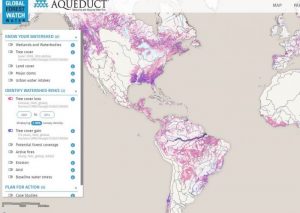Primary Functions
- Measure condition of freshwater ecosystems
- Understand capacity of an ecosystem to support populations
- Provide guidance to decisionmakers
Detailed Description
The U.N. estimates that half of the people on Earth will likely face water stress by 2030. Competition for water for drinking, food production and maintaining healthy ecosystems that protect against floods or help regulate a stable climate all place growing demands on freshwater resources. And because water flows through — and links together — many different habitats, upstream activities directly impact downstream water users. To ensure water security into the future, we must better understand, manage and value our freshwater ecosystems.
Assess freshwater ecosystem health
The Freshwater Health Index assesses the status and trends of benefits that people receive from freshwater ecosystems, including clean water, fish and recreational uses. It provides links between governance, stakeholders, their impacts on ecosystems and the consequences for ecosystem services.
Evaluate tradeoffs
The Freshwater Health Index can help users identify vulnerabilities or opportunities within a basin as well as potential impacts from climate change, land use change and infrastructure development. By exploring tradeoffs, decisionmakers can make better choices that balance the sustainability of water resources with social equity.
Catalyze change
A data-rich, user-friendly website will provide a range of stakeholders — from water managers and planners to communities, businesses, civil society organizations and policymakers — with the information they need to make better-informed decisions and help reverse the trends of freshwater ecosystem degradation and loss.The Freshwater Health Index is being tested initially in two test-beds in the heavily populated Asia-Pacific region, where decisionmakers are confronting pressures from rapid urbanization, declines in water quality and quantity, and climate change impacts such as increased exposure to floods and droughts.
- The Lower Mekong Basin in Cambodia, Laos and Vietnam directly supports the livelihoods of more than 60 million people. Here we are testing the Freshwater Health Index in the Sesan, Sreypok, Sekong River basin and the basin of Cambodia’s Tonle Sap Great Lake; and
- The Dongjiang River in the Pearl River system is the water source for almost 40 million people in southern China and provides 80% of Hong Kong’s fresh water.
Following application in the first two test beds, the Freshwater Health Index will be applied to a representative set of basins globally.





